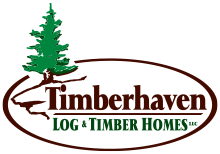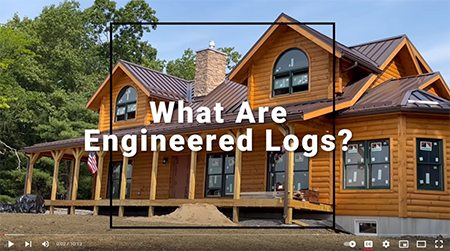What are Engineered Logs and Timbers?
One of the most commonly asked questions in the Log & Timber Home Industry is about Engineered Logs and Timbers: What are they and what are their advantages? Timberhaven Log & Timber Homes specializes in these products, so the team at Log & Timber Home Living visited the company to collect the answers for you! Watch this newly released video to learn more.
Keep reading to learn more or click: https://www.timberhavenloghomes.com/our-products/kiln-dried-engineered-logs/
Laminated and engineered terms are used interchangeably. At its simplest, an Engineered Log or Timber has less than 9% average moisture content and is made by taking 2x slabs of kiln dried wood and bonding them together to desired thickness before milling them to the profile of your home. Because it begins with thinner pieces of wood, it is easier to ensure consistency, better regulate moisture content, and select only the best quality cuts from a log.
Kiln drying is the process of using heat and evaporation in a controlled environment to remove moisture content from the wood, less than 19% average moisture content, allowing the wood to reach the moisture content it will assume during its service life, effectively preshrinking the logs or timbers to minimize warping, twisting, and checking in the future. This process differs significantly from air dried logs or timbers which are simply left in an open, uncontrolled environment to slowly dry, often resulting in a log or timber with a higher moisture content that is susceptible to excessive shrinking and warping after the home is built.
“Proper kiln drying procedures control the drying environment and reduce the amount of severity of drying induced defects. Drying wood prior to installation provides an opportunity for the wood to maintain relatively stable dimensions during service.”
~Paul Blankenhorn, Ph.D., Professor of Wood Technology, Penn State University
The final moisture content is measured in accordance to grading standards set forth by the Log & Timber Homes Council . After the 2x Engineered plies are properly dried, they are ready to be bonded together as a solid log or timber.
The laminating process begins with each ply of freshly milled lumber being run along a conveyor where glue is applied to one side of the wood. These wooden slabs are then taken up a conveyor where they are aligned and stacked, ready to go into the radio frequency dryer.
The wood is placed into the dryer which not only dries the glue but uses pressure to compress the timbers and ensure a tight bond with the glue. A radio frequency dryer works faster than traditional dryers, and the log or timber is ready for strength testing in less than six minutes.
After the lamination process is completed, a sample is cut from each new timber to ensure it meets or exceeds the strict breaking tolerances of 1300 PSI along the glue line set forth by the Log & Timber Home industry. During testing, a properly Engineered Log or Timber will break along the wood grain long before it ever breaks along the glue line.
The benefits of an Engineered Log or Timber are many. First of all, an Engineered Log or Timber experiences virtually no checking, it is dryer than other log options with an average nine percent moisture content, and different wood species can be used for the exterior and interior finishes while still accepting stains and preservatives the same as conventional logs and timbers.
Engineered Logs and Timbers are stronger than traditional solid logs and timbers because the alternating grain of the individual plies provides added strength and stability.
The environmental impact of Engineered Logs and Timbers is also less than that of conventional logs and timbers since there is less waste produced from the manufacturing process, making them an environmentally friendly, renewable building product.
“My laboratory has tested the long-term exposure performance of Timberhaven’s laminated logs. Our tests … found that laminated logs performed at a higher level than solid logs… The laminated test logs were stacked outside, fully exposed to the weather, with no exterior finish applied. … No failures of any kind have been observed during the 9 year evaluation. … Structural strength and dimensional stability during severe weather exposure shows these logs provide a mechanically strong, functionally durable and aesthetically attractive log structure.”
~Edwin J. Burke, Ph.D., Director University of Montana College of Forestry and Conservation
At Timberhaven Log & Timber Homes, we have combined the best of all manufacturing processes and structural elements into a sturdy, stable, and sustainable product – the Engineered Log and Engineered Timber. And it is available in a variety of sizes and profiles. To learn more about Timberhaven’s critically acclaimed Engineered Logs and Timbers, contact us today!



